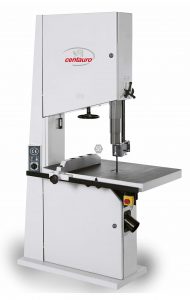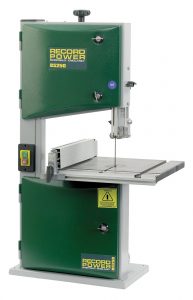- Centauro CO-600
- Timber, Manufactured Boards, Extruded Polystyrene, and Plastic
- Max material thickness: 300mm
- Cutting – large stock and straight cuts
- Workshop Category: W3
- Workshop Risk Category: Orange: Medium Risk

- Record Power BS250
- Timber, Manufactured Boards, Extruded Polystyrene, and Plastic
- Max material thickness: 50mm
- Cutting – small stock and tight curves
- Workshop Category: W3
- Workshop Risk Category: Orange: Medium Risk

The Band Saw has a thin vertical blade that allows cutting curves, rip and cross cutting stock.
To avoid accidents, the following operational safety rules must be observed by everyone using the either bandsaw
Start with a Risk Assessment to ensure a safe work area:
- Complete the online Workshop Induction before using the Bandsaw. 1st use of the machine will be supervised
- The area around the band saw must be kept clear of people, debris and sawdust
- Safety glasses or a face shield must be worn. Hearing protection should be worn if cutting plastic
- Remove loose fitting clothing, jewellery, and tie back long hair
- Familiarise yourself with the off and on button
- The dust collector must be connected to the unit and blast gate open. The air flow must not be less than 1500 Pa.
- Check the blade tension and report any faults to the workshop manager
Operational Safety Rules:
- Approach your work in the workshop and on the band saw with a safe attitude
- The blade must be 1mm from the rear roller bearing behind the blade
- The blade should be correctly tensioned – staff member to set this
- Keep the blade guard & guide no more than 5 mm above your stock material
- When operating a band saw, always place the material being cut flat against the table. Do not attempt to cut free-hand in mid-air. Don’t cut stock that is not flat on the bottom without a jig
- Wait until the motor is at full speed before beginning any cut.
- Follow the 8 cm rule from the blade; always keep fingers 8cm from the blade
- At no time should your hands be in front and in line with the cutting edge of the blade
- To control the stock, use push sticks, feather boards, or any other suitable safety device when cutting small or short stock. Use a “V” block when cutting cylindrical stock
- Cut at a moderate feed rate into the blade. Do not force a cut
- Cut relief cuts prior to cutting long or tight curves. The relief cuts will free the blade of the tension of the tight curve and the wood will fall away. The blade size will dictate the radius of the cut
- Never back out of a curve cut while the machine is running. If you need to back out of a cut, shut the machine off, after blade stops, and then back out
- Never clear small pieces while the blade is moving
- If a blade breaks, shut the machine off and stand clear until everything stops
- If the work is too large for one person to handle, get help holding the stock from a appropriately inducted/trained person
- When cutting with the table at an angle, clamp a block to the table to prevent your stock from slipping off the table
- Always disconnect the power before changing the blade or performing any other maintenance operation
- Turn off the band saw and wait until comes to a complete stop. Never stick an object into the blade to stop the machine quicker. Let it stop on its own
- Always leave the blade guard fully down on the machine bed. This ensures that no one cuts themselves whilst clearing the bed of off-cuts. It also ensures that the next person to use the machine has to set the guard for the job they are undertaking
- Before leaving the area shut off power, clean the band saw and work area


